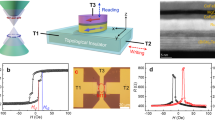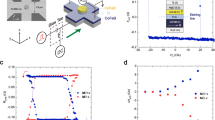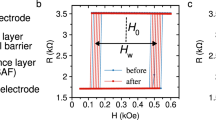Abstract
Spin-transfer torque magnetoresistive random access memory (STT-MRAM) is an attractive alternative to existing random access memory technologies due to its non-volatility, fast operation and high endurance. However, STT-MRAM does have limitations, including the stochastic nature of the STT-switching and a high critical switching current, which makes it unsuitable for ultrafast operation in the nanosecond and subnanosecond regimes. Spin–orbit torque (SOT) switching, which relies on the torque generated by an in-plane current, has the potential to overcome these limitations. However, SOT-MRAM cells studied so far use a three-terminal structure to apply the in-plane current, which increases the size of the cells. Here we report a two-terminal SOT-MRAM cell based on a CoFeB/MgO magnetic tunnel junction pillar on an ultrathin and narrow Ta underlayer. In this device, in-plane and out-of-plane currents are simultaneously generated on application of a voltage, and we demonstrate that the switching mechanism is dominated by SOT.
This is a preview of subscription content, access via your institution
Access options
Access Nature and 54 other Nature Portfolio journals
Get Nature+, our best-value online-access subscription
$29.99 / 30 days
cancel any time
Subscribe to this journal
Receive 12 digital issues and online access to articles
$119.00 per year
only $9.92 per issue
Buy this article
- Purchase on Springer Link
- Instant access to full article PDF
Prices may be subject to local taxes which are calculated during checkout



Similar content being viewed by others
Data availability
The data that support the plots within this paper and other findings of this study are available from the corresponding author upon reasonable request.
References
International Technology Roadmap for Semiconductors (ITRS, accessed 17 June 2018); http://www.itrs2.net/
Ikeda, S. et al. A perpendicular-anisotropy CoFeB–MgO magnetic tunnel junction. Nat. Mater. 9, 721–724 (2010).
Worledge, D. C., Hu, G., Abraham, D. W., Trouilloud, P. L. & Brown, S. Development of perpendicularly magnetized Ta|CoFeB|MgO-based tunnel junctions at IBM (invited). J. Appl. Phys. 115, 172601 (2014).
Sato, H. et al. MgO/CoFeB/Ta/CoFeB/MgO recording structure in magnetic tunnel junctions with perpendicular easy axis. IEEE. Trans. Magn. 49, 4437–4440 (2013).
Yuasa, S., Hono, K., Hu, G. & Worledge, D. C. Materials for spin-transfer-torque magnetoresistive random-access memory. MRS. Bull. 43, 352–357 (2018).
Dieny, B., Goldfarb, R. B. & Lee, K.-J. Introduction to Magnetic Random-Access Memory (Wiley-IEEE Press, New York, 2016).
Zhang, S. Spin Hall effect in the presence of spin diffusion. Phys. Rev. Lett. 85, 393–396 (2000).
Miron, I. M. et al. Perpendicular switching of a single ferromagnetic layer induced by in-plane current injection. Nature 476, 189–193 (2011).
Liu, L. et al. Spin-torque switching with the giant spin Hall effect of tantalum. Science 336, 555–558 (2012).
Liu, L., Lee, O. J., Gudmundsen, T. J., Ralph, D. C. & Buhrman, R. A. Current-induced switching of perpendicularly magnetized magnetic layers using spin torque from the spin Hall effect. Phys. Rev. Lett. 109, 096602 (2012).
Kim, J. et al. Layer thickness dependence of the current-induced effective field vector in Ta|CoFeB|MgO. Nat. Mater. 12, 240–245 (2013).
Garello, K. et al. Ultrafast magnetization switching by spin–orbit torques. Appl. Phys. Lett. 105, 212402 (2014).
Manipatruni, S., Nikonov, D. E. & Young, I. A. Beyond CMOS computing with spin and polarization. Nat. Phys. 14, 338–343 (2018).
Brosse, J. K. D., Liu, L. & Worledge, D. Spin Hall effect assisted spin transfer torque magnetic random access memory. US patent 20140264511A1 (2014).
Wang, Z., Zhao, W., Deng, E., Klein, J.-O. & Chappert, C. Perpendicular-anisotropy magnetic tunnel junction switched by spin-Hall-assisted spin-transfer torque. J. Phys. D 48, 065001 (2015).
van den Brink, A. et al. Spin-Hall-assisted magnetic random access memory. Appl. Phys. Lett. 104, 012403 (2014).
Lee, K.-S., Lee, S.-W., Min, B.-C. & Lee, K.-J. Threshold current for switching of a perpendicular magnetic layer induced by spin Hall effect. Appl. Phys. Lett. 102, 112410 (2013).
Cubukcu, M. et al. Ultra-fast perpendicular spin–orbit torque MRAM. IEEE. Trans. Magn. 54, 9300204 (2018).
Zhang, C., Fukami, S., Sato, H., Matsukura, F. & Ohno, H. Spin–orbit torque induced magnetization switching in nano-scale Ta/CoFeB/MgO. Appl. Phys. Lett. 107, 012401 (2015).
Lee, K.-S., Lee, S.-W., Min, B.-C. & Lee, K.-J. Thermally activated switching of perpendicular magnet by spin–orbit spin torque. Appl. Phys. Lett. 104, 072413 (2014).
Taniguchi, T., Mitani, S. & Hayashi, M. Critical current destabilizing perpendicular magnetization by the spin Hall effect. Phys. Rev. B 92, 024428 (2015).
Wang, M. et al. Field-free switching of perpendicular magnetic tunnel junction by the interplay of spin orbit and spin transfer torques. Preprint at https://arXiv.org/abs/1806.06174 (2018).
Yu, G. et al. Switching of perpendicular magnetization by spin–orbit torques in the absence of external magnetic fields. Nat. Nanotech. 9, 548–554 (2014).
Fukami, S., Zhang, C., DuttaGupta, S., Kurenkov, A. & Ohno, H. Magnetization switching by spin–orbit torque in an antiferromagnet–ferromagnet bilayer system. Nat. Mater. 15, 535–541 (2016).
You, L. et al. Switching of perpendicularly polarized nanomagnets with spin orbit torque without an external magnetic field by engineering a tilted anisotropy. Proc. Natl Acad. Sci. USA 112, 10310–10315 (2015).
Hsu, W.-H., Bell, R. & Victora, R.H. Ultra-low write energy composite free layer spin-orbit torque MRAM. IEEE Tran. Mag. https://doi.org/10.1109/TMAG.2018.2847235 (2018).
Acknowledgements
S.X.W. thanks TSMC, Stanford SystemX Alliance, Stanford Center for Magnetic Nanotechnology, and the NSF Center for Energy Efficient Electronics Science (E3S) for financial support. N.S. thanks Funai Foundation for Information Technology for the overseas scholarship. This work was supported in part by ASCENT, one of six centres in JUMP, a Semiconductor Research Corporation (SRC) programme sponsored by DARPA. The experimental work has benefited from the equipment and tools at the Stanford Nanofabrication Facility, Stanford Nano Shared Facilities, and Michigan Lurie Nanofabrication Facility (LNF), which are supported by the National Science Foundation (NSF).
Author information
Authors and Affiliations
Contributions
N.S., R.M.W. and S.X.W. conceived the experiments, N.S. and F.X. conducted the experiments, and N.S., C.B. and S.X.W. analysed the results. All authors reviewed the manuscript.
Corresponding author
Ethics declarations
Competing interests
The authors declare no competing interests.
Additional information
Publisher’s note: Springer Nature remains neutral with regard to jurisdictional claims in published maps and institutional affiliations.
Supplementary information
Supplementary Information
Supplementary Notes 1–5 and Supplementary Figures 1–10
Rights and permissions
About this article
Cite this article
Sato, N., Xue, F., White, R.M. et al. Two-terminal spin–orbit torque magnetoresistive random access memory. Nat Electron 1, 508–511 (2018). https://doi.org/10.1038/s41928-018-0131-z
Received:
Accepted:
Published:
Issue Date:
DOI: https://doi.org/10.1038/s41928-018-0131-z
This article is cited by
-
Single-nanometer CoFeB/MgO magnetic tunnel junctions with high-retention and high-speed capabilities
npj Spintronics (2024)
-
Easy-plane spin Hall oscillator
Communications Physics (2023)
-
Spintronics intelligent devices
Science China Physics, Mechanics & Astronomy (2023)
-
Magnetisation switching dynamics induced by combination of spin transfer torque and spin orbit torque
Scientific Reports (2022)
-
Forecasting the outcome of spintronic experiments with Neural Ordinary Differential Equations
Nature Communications (2022)



